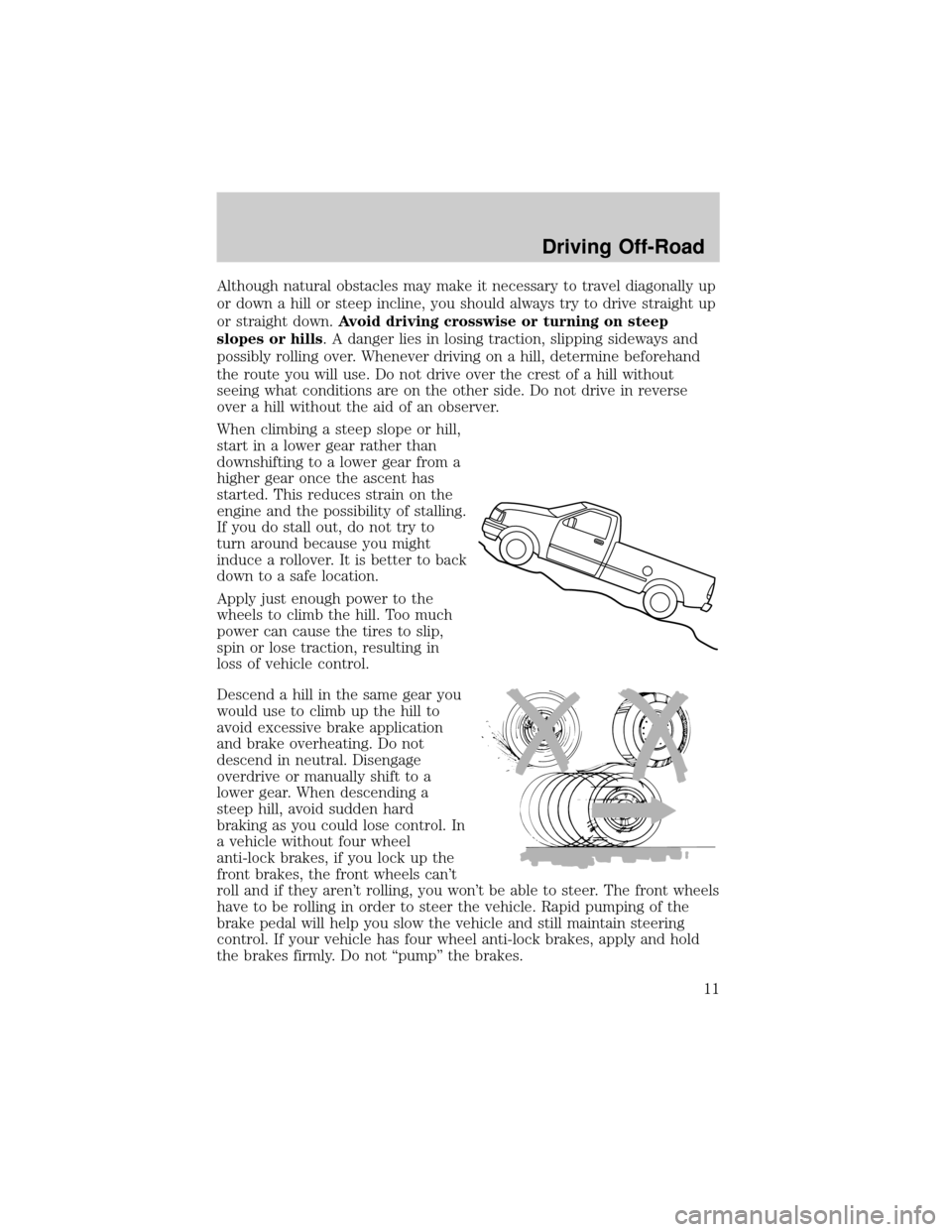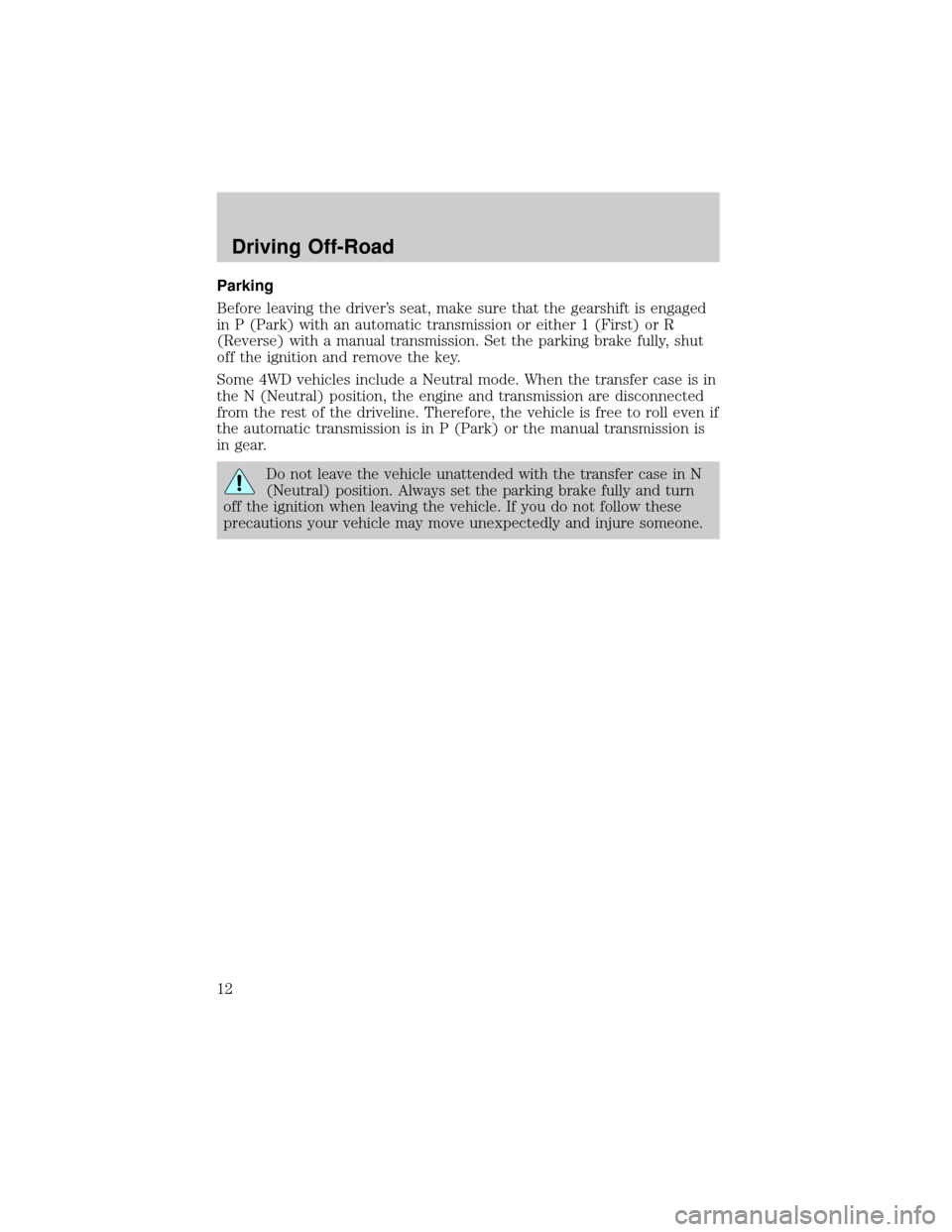engine Mercury Mountaineer 2007 Manual de Usuario (in Spanish)
[x] Cancel search | Manufacturer: MERCURY, Model Year: 2007, Model line: Mountaineer, Model: Mercury Mountaineer 2007Pages: 48, tamaño PDF: 0.37 MB
Page 32 of 48

²For vehicles with anti-lock brakes, apply and hold the brake firmly. Do
not ªpumpº the brakes. During hard stopping or stopping on slippery
surfaces, you may feel or hear a pulsing or vibration in the brake
pedal. Do not be alarmed because this is your anti-lock brake system
working. See your ªOwner's Guideº for additional information on the
operation of the anti-lock brake system.
Parking
Before leaving the driver's seat, make sure that the gearshift is engaged
in P (Park) with an automatic transmission or either 1 (First) or R
(Reverse) with a manual transmission. Set the parking brake fully, shut
off the ignition and remove the key.
Some 4WD vehicles include a Neutral mode. When the transfer case is in
the N (Neutral) position, the engine and transmission are disconnected
from the rest of the driveline. Therefore, the vehicle is free to roll even if
the automatic transmission is in P (Park) or the manual transmission is
in gear.
Do not leave the vehicle unattended with the transfer case in N
(Neutral) position. Always set the parking brake fully and turn
off the ignition when leaving the vehicle. If you do not follow these
precautions your vehicle may move unexpectedly and injure someone.
Driving On Roadways
8
Page 35 of 48

Although natural obstacles may make it necessary to travel diagonally up
or down a hill or steep incline, you should always try to drive straight up
or straight down.Avoid driving crosswise or turning on steep
slopes or hills. A danger lies in losing traction, slipping sideways and
possibly rolling over. Whenever driving on a hill, determine beforehand
the route you will use. Do not drive over the crest of a hill without
seeing what conditions are on the other side. Do not drive in reverse
over a hill without the aid of an observer.
When climbing a steep slope or hill,
start in a lower gear rather than
downshifting to a lower gear from a
higher gear once the ascent has
started. This reduces strain on the
engine and the possibility of stalling.
If you do stall out, do not try to
turn around because you might
induce a rollover. It is better to back
down to a safe location.
Apply just enough power to the
wheels to climb the hill. Too much
power can cause the tires to slip,
spin or lose traction, resulting in
loss of vehicle control.
Descend a hill in the same gear you
would use to climb up the hill to
avoid excessive brake application
and brake overheating. Do not
descend in neutral. Disengage
overdrive or manually shift to a
lower gear. When descending a
steep hill, avoid sudden hard
braking as you could lose control. In
a vehicle without four wheel
anti-lock brakes, if you lock up the
front brakes, the front wheels can't
roll and if they aren't rolling, you won't be able to steer. The front wheels
have to be rolling in order to steer the vehicle. Rapid pumping of the
brake pedal will help you slow the vehicle and still maintain steering
control. If your vehicle has four wheel anti-lock brakes, apply and hold
the brakes firmly. Do not ªpumpº the brakes.
Driving Off-Road
11
Page 36 of 48

Parking
Before leaving the driver's seat, make sure that the gearshift is engaged
in P (Park) with an automatic transmission or either 1 (First) or R
(Reverse) with a manual transmission. Set the parking brake fully, shut
off the ignition and remove the key.
Some 4WD vehicles include a Neutral mode. When the transfer case is in
the N (Neutral) position, the engine and transmission are disconnected
from the rest of the driveline. Therefore, the vehicle is free to roll even if
the automatic transmission is in P (Park) or the manual transmission is
in gear.
Do not leave the vehicle unattended with the transfer case in N
(Neutral) position. Always set the parking brake fully and turn
off the ignition when leaving the vehicle. If you do not follow these
precautions your vehicle may move unexpectedly and injure someone.
Driving Off-Road
12